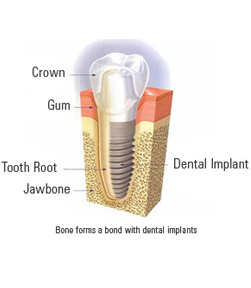

Before the development of implant dentistry, patients only had the option of dentures to replace missing teeth.
 Dental Implants
Dental Implants Dental implants are synthetic structures placed in the area of the missing tooth, normally occupied by the root. The dental implant is anchored to the jawbone, or metal framework on the bone, to act as a foundation for a replacement tooth, or a permanent bridge. Implants can also be used to attach dentures in some instances.
For a successful dental implant to take hold, the patient must first have proper bone density, and a strong immune system. In the cases where these isn't enough bone, a bone graft procedure may become necessary. This procedure is sometimes called bone augmentation, or a guided bone regeneration. Furthermore, dental implants require strict oral hygiene, and the patient's natural teeth and the supporting tissues near where the implant will be placed, must be in good health. Proper oral care is essential to ensure they last a long time.
Ideal for almost anyone who is currently missing teeth or is at risk of losing teeth, dental implants look and feel almost exactly like natural teeth. It is very difficult for anyone to tell the difference.
A surgical procedure is neccesary to prepare the area for the implant, and to place the implant in the mouth. Patients are administered anesthesia for this procedure, and, if necessary, antibiotics to stave off infection afterwards. After this procedure, the implant will require time to take hold, and for the bone tissure to build up and anchor the implant.